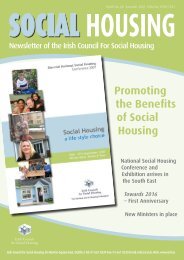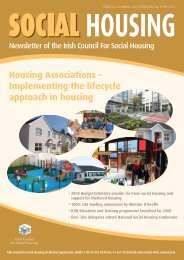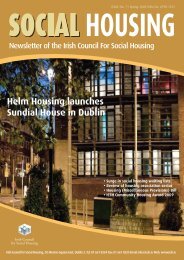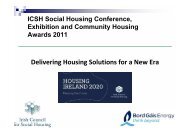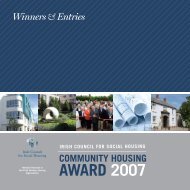National Housing Strategy for People with a Disability 2011 - 2016
National Housing Strategy for People with a Disability 2011 - 2016
National Housing Strategy for People with a Disability 2011 - 2016
Create successful ePaper yourself
Turn your PDF publications into a flip-book with our unique Google optimized e-Paper software.
4.9 Based on the analysis above, it may be concluded that:• A majority of people <strong>with</strong> disabilities live in owner occupied homes – it can beinferred that approximately half of these are the homeowner or the spouse of ahome owner, while some are children living in the parental home 18 .• The ability to achieve home ownership is slightly lower <strong>for</strong> people <strong>with</strong> disabilitiesthan <strong>for</strong> those who do not have a disability. This suggests that people <strong>with</strong>disabilities who do own their own home may have acquired a disability later in life.• A smaller proportion of people <strong>with</strong> a psychological or emotional condition are homeowners compared to other categories of disability.• There are fewer people <strong>with</strong> disabilities in private rented accommodation whencompared <strong>with</strong> the total Irish population.• <strong>People</strong> <strong>with</strong> disabilities are more likely to rent from local authorities or approvedhousing bodies than private landlords.<strong>Disability</strong> Databases4.10 Data in relation to, inter alia, the housing status of people <strong>with</strong> certain disabilities, iscollected by the Health Research Board (HRB), in the <strong>National</strong> Intellectual <strong>Disability</strong>Database (NIDD) and the <strong>National</strong> Physical and Sensory <strong>Disability</strong> Database (NPSDD). TheNIDD was established in 1995 and has over 26,000 people registered. The NPSDD wasestablished in 2002 and has circa 29,000 people registered. To be included on thedatabases a person must require or use a specialist disability service. It should be notedthat registration is voluntary and consent is required. As the databases are voluntary, theydo not accurately represent the extent of the prevalence of disability 19 . The NPSDDcaptures data on approximately two thirds of individuals <strong>with</strong> physical or sensory disabilitiesaged 65 years and under. Those over 66 years of age are not included on this database.18There is no direct data in respect of how many people <strong>with</strong> disabilities who live in owner occupied houses are,in fact, the homeowner. However, it is reasonable to infer that people <strong>with</strong> disabilities are pro rata heads ofhouseholds or children (young or adult) in these homes. On that basis, it would be expected that 38% ofpeople <strong>with</strong> disabilities are homeowners or the spouse of a homeowner, and 8% are children (young or adult) inan owner occupied parental home, <strong>with</strong> approximately 22% being other occupants of owner occupied housing,i.e. parent living <strong>with</strong> adult child, brother/sister/niece/grandchild of the homeowner, etc.19It is estimated that the NIDD captures details of 90 – 95% of people <strong>with</strong> intellectual disabilities. <strong>People</strong> mostlikely to be under-represented on the database are those <strong>with</strong> mild intellectual disabilities and very youngchildren.44



